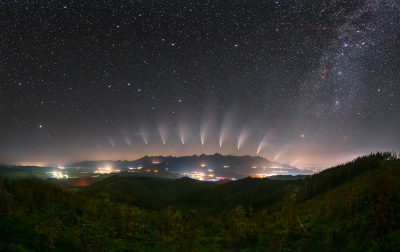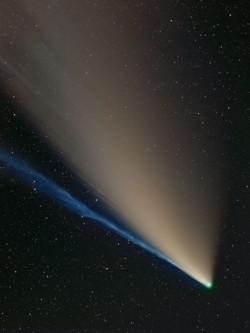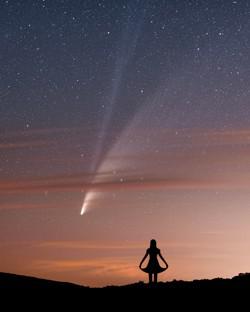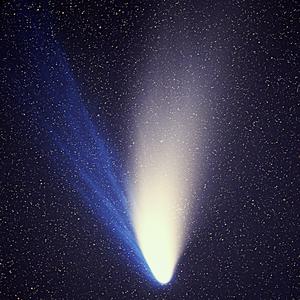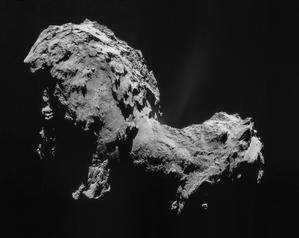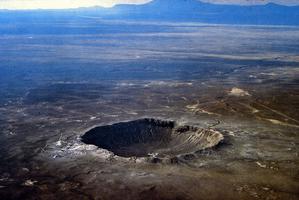Glossarbegriffe: Komet
Description: Ein Komet ist ein kleines Objekt im Sonnensystem, das aus einem Kern besteht, der sich aus einer Mischung aus verschiedenen Arten von Eis, Gestein und Staub zusammensetzt - ein schmutziger Schneeball. Kometenkerne können eine Größe von einigen hundert Metern bis zu einigen zehn Kilometern haben. Die meisten Kometen haben stark elliptische Bahnen. Wenn sich der Komet der Sonne nähert, verdampft ein Teil des Oberflächeneises und wird vom Sonnenwind fortgeweht, sodass die charakteristischen Koma- und Schweifmerkmale entstehen. Wir sehen Kometen, weil das Sonnenlicht von der Koma oder dem Schweif oder (bei sonnenfernen Kometen) vom Kern reflektiert wird. Kometen werden als "periodisch" oder "kurzperiodisch" eingestuft, wenn ihr Durchgang mehr als einmal beobachtet wurde oder ihre Periode bekanntlich weniger als 200 Jahre beträgt, und ansonsten als "aperiodisch".
Zugehörige Glossarbegriffe:
See this term in other languages
Term and definition status: The original definition of this term in English have been approved by a research astronomer and a teacher The translation of this term and its definition is still awaiting approval
The OAE Multilingual Glossary is a project of the IAU Office of Astronomy for Education (OAE) in collaboration with the IAU Office of Astronomy Outreach (OAO). The terms and definitions were chosen, written and reviewed by a collective effort from the OAE, the OAE Centers and Nodes, the OAE National Astronomy Education Coordinators (NAECs) and other volunteers. You can find a full list of credits here. All glossary terms and their definitions are released under a Creative Commons CC BY-4.0 license and should be credited to "IAU OAE".
If you notice a factual or translation error in this glossary term or definition then please get in touch.
Zugehörige Medien
Neowise's metamorphosis, by Tomáš Slovinský and Petr Horálek, Slovakia
Bildnachweis: Tomáš Slovinský and Petr Horálek/IAU OAE
License: CC-BY-4.0 Creative Commons Namensnennung 4.0 International (CC BY 4.0) icons
Comet C/2020F3 (Neowise) with separate dust and ion gas tails and a green glowing coma, by Dietmar Gutermuth, Germany
Bildnachweis: Dietmar Gutermuth/IAU OAE
License: CC-BY-4.0 Creative Commons Namensnennung 4.0 International (CC BY 4.0) icons
Hello Comet, shall we dance?, by Robert Barsa, Slovakia
Bildnachweis: Robert Barsa/IAU OAE
License: CC-BY-4.0 Creative Commons Namensnennung 4.0 International (CC BY 4.0) icons
Comet Hale-Bopp
Bildnachweis: E. Kolmhofer, H. Raab; Johannes-Kepler-Observatory, Linz, Austria credit link
License: CC-BY-SA-3.0 Creative Commons Namensnennung - Weitergabe unter gleichen Bedingungen 3.0 Unported icons
Comet 67P/Churyumov-Gerasimenko
Bildnachweis: ESA/Rosetta/NAVCAM credit link
License: CC-BY-SA-3.0-IGO Creative Commons Namensnennung - Weitergabe unter gleichen Bedingungen 3.0 IGO icons
Related Activities
Meteoroids, Meteors and Meteorites
astroEDU educational activity (links to astroEDU website) Description: Unveiling the mystery of "shooting stars": meteors, meteorites and meteroids
License: CC-BY-4.0 Creative Commons Namensnennung 4.0 International (CC BY 4.0) icons
Tags:
Geology
Age Ranges:
6-8
, 8-10
, 10-12
, 12-14
Education Level:
Middle School
, Primary
Areas of Learning:
Interactive Lecture
Costs:
Low Cost
Duration:
1 hour 30 mins
Group Size:
Group
Skills:
Analysing and interpreting data
, Asking questions
, Communicating information
, Engaging in argument from evidence
Measuring the average speed of a comet
astroEDU educational activity (links to astroEDU website) Description: Using telescope images of comet C/2019 Y4 we calculate its average speed and understand what a physical quantity is
License: CC-BY-4.0 Creative Commons Namensnennung 4.0 International (CC BY 4.0) icons
Tags:
Software
, average speed
Age Ranges:
12-14
, 14-16
, 16-19
, 19+
Education Level:
Secondary
Costs:
Free
Duration:
1 hour 30 mins
Group Size:
Group
Skills:
Analysing and interpreting data
, Developing and using models
, Engaging in argument from evidence
